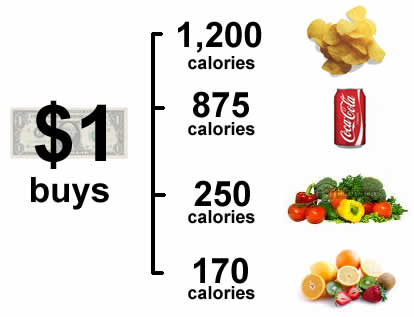In the doctor’s office, I saw the cover article of a recent issue of Time magazine was Getting Real About the High Price of Cheap Food. Inside were some interesting facts. For one, people in the U.S. actually spend less on food now than 30 years ago:
For all the grumbling you do about your weekly grocery bill, the fact is you’ve never had it so good, at least in terms of what you pay for every calorie you eat. According to the USDA, Americans spend less than 10% of their incomes on food, down from 18% in 1966. Those savings begin with the remarkable success of one crop: corn. Corn is king on the American farm, with production passing 12 billion bu. annually, up from 4 billion bu. as recently as 1970. When we eat a cheeseburger, a Chicken McNugget, or drink soda, we’re eating the corn that grows on vast, monocrop fields in Midwestern states like Iowa.
I was most concerned with the actual nutritional value we get from our food. If you look at calories vs. cost, again we see that the foods with the most nutritional value cost the most. This is similar to my popular post exploring What Does 200 Calories Cost?, which found bread and pasta on the cheap end, and fresh fruits and vegetables on the expensive end.
Result: The cheap and filling food has way too many empty calories.

A study in the American Journal of Clinical Nutrition found that a dollar could buy 1,200 calories of potato chips or 875 calories of soda but just 250 calories of vegetables or 170 calories of fresh fruit. With the backing of the government, farmers are producing more calories — some 500 more per person per day since the 1970s — but too many are unhealthy calories. Given that, it’s no surprise we’re so fat; it simply costs too much to be thin.
So what is there to do? The Time article suggests that organic is one way to go:
Organic food continues to cost on average several times more than its conventional counterparts, and no one goes to farmers’ markets for bargains. But not all costs can be measured by a price tag. Once you factor in crop subsidies, ecological damage and what we pay in health-care bills after our fatty, sugary diet makes us sick, conventionally produced food looks a lot pricier.
Personally, I think we should start with finding the foods that provide the best balance between cost and nutrition. I’m still learning, but am trying to incorporate things like lentils, beans, and whole grains into my white-bread-and-rice world. Also, we’ve started buying a “box of vegetables” from a local organic farm (see Community Supported Agriculture). We don’t get to choose what goes in the box and are thus forced to be creative, but on a per-pound basis it costs less than half what a grocery store would charge for non-organic equivalents.
Read more about Getting Value For Your Food Dollar: Nutrition vs. Cost…
No comments:
Post a Comment